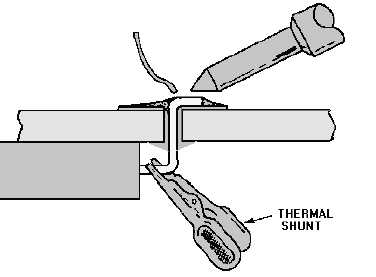3-24
Figure 3-16.—Thermal shunt.
APPLICATION OF SOLDER AND SOLDERING IRON TIP.—Before solder is applied to the
joint, the surface temperature of the parts being soldered is increased above the solder melting point. In
general, the soldering iron is applied to the point of greatest mass at the connection. This increases the
heat in the parts to be soldered. Solder is then applied to a clean, fluxed, and properly heated surface.
When properly applied, the solder melts and flows without direct contact with the heat source and
provides a smooth, even surface that feathers to a thin edge.
Molten solder forms between the tip and the joint, creating a heat bridge or thermal linkage. This
heat bridge causes the tip to become part of the joint and allows rapid heat transfer. A solder (heat) bridge
is formed by melting a small amount of solder at the junction of the tip and the mass being soldered as the
iron is applied. After the tip makes contact with the lead and the pad and after the heat bridge is
established, the solder is applied with a wiping motion to form the solder bond. The completed solder
joint should be bright and shiny in appearance. It should have no cracks or pits, and the solder should
cover the pad. Examples of preferred solder joints are shown in figure 3-17. They are referred to as full
fillet joints.

